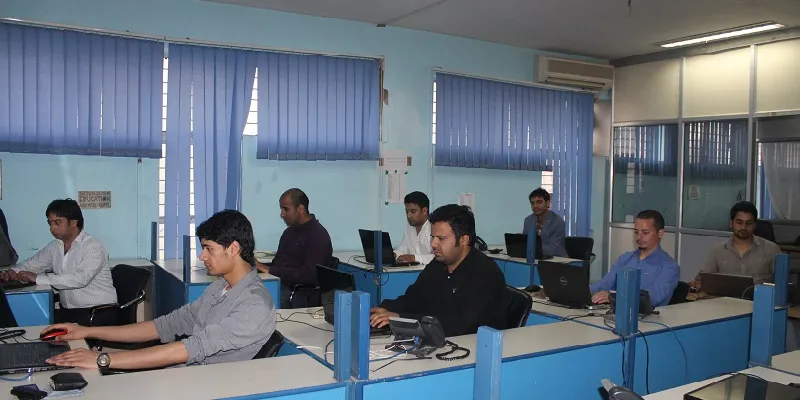How this 27-year-old artist is rolling the Kashmir canvas across the world
Kashmir. The name signifies lofty mountains and snow-covered peaks, green meadows and majestic rivers. It also signifies over two decades of conflict that have left an indelible mark on the hearts and minds of people, world over. There is such complexity yet substantial beauty to Kashmir, that it should be the land where artists find home. After all, where else can an empty canvas find so many delectable and heart-breaking tales to depict at the same time?
It is shocking, to say the least, that in the history of Kashmir, there hasn’t been a single art gallery – a space that has the potential to intellectually and creatively redefine the Valley and the minds of its people. But then, history has its way by producing a handful of men and women who redefine it. And one such man is 27-year-old Syed Mujtaba Rizvi, who founded Kashmir’s first art initiative, Kashmir Art Quest.

The man behind the canvas

Born in Srinagar, Rizvi spent much of his childhood in conflict zones of Iran and the Middle East before returning to finish his high school. He was 16 when he pushed his school management to do something in the art space and ended up having his first small-scale public show. Enthused by the response, he took up painting seriously, hosting independent shows in cities such as Mumbai and even started selling works across the world.
Although painting was his first love, he was gearing up to become an engineer. Everyone thought he wouldn’t pursue art seriously. But how wrong was the world, for Rizvi came back to Kashmir and formally registered his dream in the form of Kashmir Art Quest, in 2009.
Finally, a platform for Kashmiri artists
A revolutionary independent organisation, Kashmir Art Quest is striving to create opportunities and platforms for Kashmiri artists at local, national and international level. Also, Rizvi is working towards setting up an international contemporary art scene in the Valley.
Recollecting the inaugural exhibition, Rizvi says,
It was a two-day show, which displayed 200 works of 40 emerging and nine senior artists, the largest of its kind in Jammu and Kashmir’s history. On the second day, the ‘2010 Kashmir Unrest’ took place which claimed the lives of over 110 people. The incident shaped Kashmir Art Quest’s mission in many ways – to never curb the freedom of expression of our artists. The intellectual, liberal thoughts that are creatively translated on the canvas are a bold representative of what Kashmir is and how it could be.
In the last seven years, Kashmir Art Quest has showcased the works of over 200 senior and emerging artists alike across the world. The organisation is also at the forefront of major calamities, political disruptions and tensions that surface in the State. Last year, after the Kashmir floods, Rizvi and his team initiated a month-long exhibition in New Delhi called ‘ReSTART Kashmir’ – a fundraiser auction of contemporary art. ReSTART, through its works, displayed Kashmir’s resilience and how people could find courage and hope despite everything. Rizvi says, “We raised close to Rs 8 lakh, which was given to the identified families through our partner NGO, SOS Kashmir.”
Rolling the Kashmir canvas across the world
Rizvi’s most ambitious project, however, is ‘Keep the Canvas Rolling’. He reasons,
Kashmir is interpreted differently, everywhere. Imagine how beautiful it would be if all the varied emotions are reflected visually on one canvas?
And, Keep the Canvas Rolling took birth with a simple aim – to ‘interpret Kashmir visually’.

A 33×5 ft travelling canvas, which will journey through 12 countries in a year, allowing 200 global artists to collaborate and produce a single work of art, this initiative is the first-of-its-kind in the world. The canvas is proactively being topped with diverse performances incorporating music, dance and theatre everywhere. Next year, once the canvas reaches home, it will find itself a permanent installation by the banks of Srinagar’s Dal Lake. The entire initiative will be followed by a published book which will document the journey through writings by artists, critics, curators etc.

The canvas has already rolled over India, Pakistan, Switzerland, United Kingdom, Iran and Malaysia, to name a few. And in every country, something unique emerges. For instance, in Schaffhausen, Switzerland, artists poured beeswax on the canvas reflecting the flood situation in Kashmir and scratched the surface with gold and colour signifying the undying spirit. In India, a Hyderabadi artist painted a tourist whose camera is capturing the magnificence on Srinagar’s mountains which was shattered by another artist who painted a pair of masked eyes in the very mountains. A blogger captures the essence of the canvas beautifully,
A uni-dimensional perspective is unaffordable; a shift in discourse is pressing… Qashmir, Cashmir, Kashmere, Cashemire, Cushmeer or Cachimere? There can never be a single answer.

Indeed, Rizvi is creating a global conversation about Kashmir – its art, people, culture, society and politics.
Gallerie One – inaugurated and vandalised in less than a month
In one of the world’s most militarised zones, Rizvi showed hope. Last year, he established a contemporary arts and research centre in Srinagar called ‘Gallerie One’. The centre has a world-class art gallery, digital media lab, art library, research centre and an archiving and cataloguing centre. However, in an unanticipated turn of events, State tourism officials vandalised it. The gallery, which had proudly housed works of over 100 renowned artists, was broken into pieces in no time. Rizvi says the works were worth a few crore rupees.

But by now, Rizvi’s determination is well-established. He’s preparing to re-launch the centre by the end of this year in a different location in Srinagar, as well as in New Delhi. He says,
I nearly gave up but a possible social, cultural and intellectual evolution due to the power of art would have been completely erased. This time, we will be bigger. We are also introducing art-entrepreneurship, wherein four artists would reside in Kashmir for eight weeks and curate pieces by working with local artists and craftsmen.
Another first.
Rizvi had set out to prove that there is some ground-breaking work happening in Kashmir. He’s clearly done much more than that. He’s shown that Kashmir is indeed the “perfect archetype of the promised land of God.”

Read More:
The call of home made this US-returned entrepreneur revive Kashmir’s apple industry
29-year-old Arifa Jan from Kashmir has taken up the daunting task to revive the lost art of numdha handicrafts
How Kashmir Box is putting Kashmir on the world map for all the right reasons







